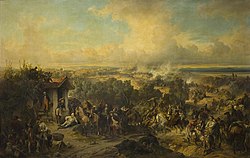This article includes a list of general references, but it lacks sufficient corresponding inline citations .(September 2025) |
| Italian and Swiss expedition | |||||||
|---|---|---|---|---|---|---|---|
| Part of the War of the Second Coalition | |||||||
 Map of Suvorov's campaign in Italy and Switzerland | |||||||
| |||||||
| Belligerents | |||||||
| | Swiss rebels | ||||||
| Commanders and leaders | |||||||
| | | ||||||
| Strength | |||||||
| ? French ? Helvetes ? Polish | 178,253 Austrians [3] 65,000 Russians [4] ? Swiss rebels | ||||||
| Casualties and losses | |||||||
| In Italy: Unknown number of killed and wounded 80,000 captured, 3,000 cannons, 200,000 guns [5] | Unknown | ||||||
The Italian and Swiss expedition of 1799 [6] was a military campaign undertaken by a combined Austro-Russian army under overall command of the Russian Marshal Alexander Suvorov against French forces in Piedmont and Lombardy (modern Italy) and the Helvetic Republic (present-day Switzerland). The expedition was part of the Italian campaigns of the French Revolutionary Wars in general, and the War of the Second Coalition in particular. It was one of 'two unprecedented Russian interventions in 1799', the other being the Anglo-Russian invasion of Holland (August–November 1799). [6]


















